Castle Caereinion is a small village and community in Montgomeryshire, upon the River Banwy, around eight miles west of Welshpool, and four miles east of Llanfair Caereinion. The village gains its name from an ancient castle, built in 1156 by Madog ap Maredudd. The village Church is dedicated to St. Garmon, and within its Churchyard sits the village war memorial, in the form of a Celtic Cross, which commemorates the villagers who fell during the Great War.
The Great War, 1914-1918
William Thomas Astley, Private, 355230, Royal Welsh Fusiliers. William was the son of John Astley and Elizabeth Astley (nee Rogers), of Castle Caereinion. He lived at 36, Park Road, Cwmpark prior to the war, where he worked as an underground colliery repairer. William returned home following the outbreak of war and enlisted into the Montgomeryshire Yeomanry at Welshpool on 27 August 1914. On 5 August 1914 the Montgomeryshire Yeomanry had been mobilised at Welshpool, as part of the South Wales Mounted Brigade, before moving via Hereford to Thetford, to join the 1st Mounted Division. On 4 March 1916 the 1st Mounted Division sailed for Egypt to join the EEF. On 4 March 1917 the battalion merged with the Welsh Horse Yeomanry to form the 25th (Montgomery & Welsh Horse Yeomanry) Battalion, Royal Welsh Fusiliers, as part of the newly formed 231 Brigade, 74th (Yeomanry) Division. The Division had formed in Egypt in January 1917 and had fought through the Palestinian Campaign, at the Battles of Gaza and the Battle and capture of Jerusalem. Due to the terrible casualties suffered by the British on the Western Front in March and April 1918 the Division was recalled to the Western Front, and arrived at Marseilles during May 1918. The Division trained near Le Cauroy before taking over positions in the St. Floris Sector, moving into the front line between the La Bassée Canal and the River Lys, with the left resting on the small village of Corbie. The Division faced the recently lost town of Merville, some 3,000 yards away. To the south, the Allies launched their offensive on 21 August 1918, and began the great advance towards the Hindenburg Line. The 74th Division was transferred south to join the offensive and assembled around Beaucourt Chateau before moving forwards into the battle area. William was killed in action here soon afterwards, when the 25th RWF was holding the line near Benjamin Post, on 16 September 1918. The 29-year-old is buried in Ste. Emilie Valley Cemetery, Villers-Faucon, France.
Arthur Frederick Bailey, Lance Corporal, 30853, Devonshire Regiment. Arthur was born at Lakenheath, Suffolk in 1891, the son of Thomas and Amelia Bailey. His father was a postman, and by 1911 the family was living at Castle Caereinion, where Arthur gained work as a gamekeeper. Arthur enlisted at Worcester into the 9th Battalion, Worcestershire Regiment soon after the outbreak of war. The battalion joined 39 Brigade, 13th (Western) Division on Salisbury Plain, before moving to Blackdown, Aldershot and on 24 June 1915 sailed from Avonmouth, landing at Gallipoli on 13 July 1915. Arthur was invalided home at some time afterwards, and upon recovering was drafted to France in the summer of 1917, joining the 2nd Battalion, Devonshire Regiment. The battalion was attached to 23 Brigade, 8th Division. The Division was in the Railway Wood sector at Ypres when the Passchendaele offensive was launched and the 2nd Devon’s took part in the initial assault, suffering over 200 casualties. The Division remained at Ypres throughout the offensive, spending time in and out of the front line, over the coming months. The Division then moved slightly south to the Ploegsteert Sector in October, before returning to Ypres, and taking over positions on Passchendaele Ridge. The Division wintered in the Salient, with its battalions rotating for duty in the trenches and in reserve. Arthur was killed in action here during a trench raid on Teal Cottage on 3 March 1918. The 25-year-old has no known grave and is commemorated on the Tyne Cot Memorial, Belgium.
Francis Harold Bebb, Gunner, 138715, Royal Field Artillery. Francis was of John Maurice Bebb and Jemima Bebb (nee Jones), of Bank Farm, Castle Caereinion. He was educated at Welshpool Grammar School and worked as a clerk in the London, City and Midland Bank Chester, prior to the war. Francis enlisted into the Royal Field Artillery at Chester, and was posted to A Battery, 103rd Brigade, RFA. The brigade was attached to the 23rd Division, and embarked for France in August 1915, concentrating near Tilques. The Division saw its first major action at the Battle of Albert, where it captured Contalmaison, and then fought at the Battle of Bazentin, the Battle of Pozieres, the Battle of Flers-Courcelette, the Battle of Morval and the Battle of Le Transloy, where it captured Le Sars. In June 1917 the Division took part in the Battle of Messines Ridge, and then took part in the Third Battle of Ypres from 31 July onwards, fighting at the Battle of the Menin Road, the Battle of Polygon Wood, the First Battle of Passchendaele and the Second Battle of Passchendaele. Francis was killed in action near Ypres on 21 October 1917 when a German shell crashed into his gun battery, killing most of the gun crew. The 20-year-old is buried in La Clytte Military Cemetery, Belgium.
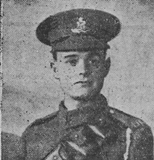
Harry Cooper, Lance Corporal, 39148, South Wales Borderers. Harry was born in Manchester in 1895, the son of Charles Calverley Cooper and Sinah Cooper (nee Griffiths). His father died in 1904, so Sinah moved back to her native Castle Caereinion with her young family. Harry went into service at Trefnant, Maesmawr as a young man. He enlisted at Welshpool into the Montgomeryshire Yeomanry and was probably posted to Park Hall, Oswestry for training. He was probably posted to France in the summer of 1916, joining the 1st Battalion, South Wales Borderers, which was attached to 3 Brigade, 1st Division. He probably joined the battalion following heavy losses on the Somme that year. The Division followed the German retreat to the Hindenburg Line in early 1917, and were then briefed for an operation on the Flanders Coast, moving there during the summer of 1917. However, the Passchendaele offensive became bogged down, so the Division was sent to Ypres, and fought at the Second Battle of Passchendaele. After spending the winter in Flanders, the Division was near Éstaires when the second phase of the German Spring Offensive struck on 9 April 1918 and saw heavy fighting before being transferred south to the Arras sector. The Division then took part in the great Allied offensive from 21 August onwards, driving towards the Hindenburg Line, and once the line was broken the Division fought at the Battles of Beaurevoir, the Selle and the Sambre. Harry was badly wounded during the Battle of Beaurevoir and was hospitalised at the 6th General Hospital, Rouen, where his foot was amputated. He died of septicaemia there on 12 October 1918, aged 23. Harry is buried in St. Sever Cemetery Extension, Rouen, France.
Edward Evans, Private, 152908, Canadian Infantry. Edward was born on 7 February 1890, the son of Edward and Ann Evans, of Cefn Crin, Castle Caereinion. He emigrated to Canada prior to the war and became a farmer at Medora, Manitoba. On 11 April 1916 Edward enlisted at Brandon, Manitoba into the 79th Overseas Battalion, Canadian Expeditionary Force. On 22 May 1916 the battalion sailed for England aboard the SS Baltic, and disembarked at Liverpool on 30 May, before entraining for the Canadian Camp at East Sandling. On 5 January 1917 Edward landed in France and was posted to the 31st Battalion, Canadian Infantry, which was attached to the 6th Canadian Brigade, 2nd Canadian Division. Edward would have taken part in the famous Canadian assault on Vimy Ridge from 9 April 1917, and following the capture of the ridge, the Canadians continued to fight to the east, during the attack on La Coulotte and the Battle of Arleux. The Canadians then fought during the Third Battle of the Scarpe the following month. Edward was killed in action near Vimy on 26 July 1917. The 29-year-old is buried in Fosse No. 10 Communal Cemetery Extension, Sains-en-Gohelle, France. His brother, Richard, had been killed in France just two months earlier.
Richard Evans, Private, 54117, Royal Welsh Fusiliers. Richard was the son of Edward and Ann Evans, of Cefn Crin, Castle Caereinion. He worked as a cowman at Tynllan Farm, Castle Caereinion prior to the war. Richard enlisted into the Royal Welsh Fusiliers at Welshpool, and was drafted to France in the autumn of 1916, joining the 2nd Battalion, Royal Welsh Fusiliers, which was attached to 19 Brigade, 33rd Division. The Division had seen heavy fighting on the Somme during the summer of 1916, and had suffered heavy casualties, especially at Bazentin Ridge and High Wood. The 2nd RWF then spent most of October in reserve, rebuilding at Lucheux, before moving back into the line and moved into trenches at Lesboeufs. The Division spent the winter in the Suzanne area, and at the beginning of April 1917 began to move away from the Somme, taking over positions facing the Hindenburg Line at Croisilles, east of Boiry-Becquerelle. On 23 April the battalion took part in a costly assault against the Hindenburg Line and when relieved the following night moved to Basseux to rest. On 15 May the battalion moved back into support positions near St. Leger, and on 20 May witnessed another attack by the 33rd Division against the Hindenburg Line, which saw a section of the outer line captured. On 27 May 1917 the battalion was still in reserve positions when it came under shellfire from German artillery. Richard was killed during the barrage that day. The 28-year-old has no known grave and is commemorated on the Arras Memorial, France. His brother, Edward, was killed in France two months later.
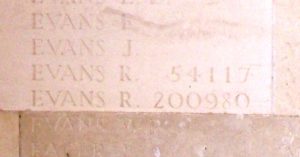
George Herriman, Lance Corporal, 1136, Royal Warwickshire Regiment. George was the son of Richard Herriman and Mary Herriman (nee Beckett), of 2, Styche Cottages, Nobridge, Market Drayton, Shropshire. He lived at Castle Caereinion prior to the war. George enlisted into the 14th Battalion, Royal Warwickshire Regiment soon after the outbreak of war. The battalion was raised at Birmingham and became attached to 95 Brigade, 32nd Division, moving to Codford, Salisbury Plain before landing at Boulogne on 21 November 1915. On the following month the battalion transferred to 13 Brigade, 5th Division and moved to the Somme sector. Early in March 1916 the Division moved to positions between St. Laurent-Blangy and Vimy, in the Arras sector, and in June the Division moved back into the Somme sector, to prepare to take part in the forthcoming Somme offensive. On 1 July 1916 the Battle of the Somme opened, and the Division took over a section of the old German line between Longueval and Bazentin-le-Grand on 19 July. Over the coming days the Division moved forwards, and took part in the desperate fighting for High Wood from 22 July. After two days of intense fighting, the 14th Warwick’s moved back to Pommiers Redoubt to rest and on 29 July received orders to move back into the front line and at 06.10 on 30 July 1916 the battalion took part in another assault against the German line. The attacking troops were met with a stout defence, as the German trenches had not been touched by the preparatory artillery barrage and, as a result, heavy casualties were suffered. George was killed in action during the attack that morning. The 26-year-old has no known grave and is commemorated on the Thiepval Memorial, France. His brother, Victor John Herriman, was serving with the Grenadier Guards, and died of wounds at Ypres on 20 August 1917.
David Frederick Jones, Private, 60748, Welsh Regiment. David was the son of Frederick Jones and Margaret Jones (nee Humphreys), of Tynycoed, Cyfronydd, Castle Caereinion. He worked for the Cambrian Railways prior to enlisting at Wrexham into the Royal Welsh Fusiliers. After completing his training, David was drafted to France, and was transferred to the 14th Battalion, Welsh Regiment, which was attached to 114 Brigade, 38th (Welsh) Division. He probably joined the battalion near Armentieres, where it was rebuilding following heavy losses at Ypres, especially during the assault of the 38th (Welsh) Division on the Pilckem Ridge on 31 July. The Division held a section of front line here until the end of March 1918, when it was transferred south to the Somme sector, to relieve the battered 2nd and 47th Division in the line facing Bouzincourt Ridge, following their withdrawal in front of the German offensive. By 12 April the 14th Welsh had taken over a section of the Divisional front, and began the usual routine of trench rotation, before being relieved on 19 April, moving into Brigade reserve. David was wounded during this period and was evacuated to the 130th Field Ambulance at Warloy-Baillon, where he died of his wounds on 23 April 1918, aged 19. He is buried in Warloy-Baillon Communal Cemetery Extension, France. He is also commemorated on the Cambrian Railways Memorial, Oswestry.
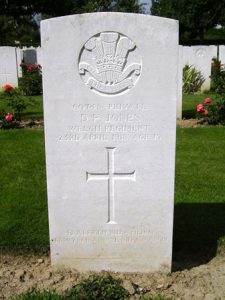
Thomas Edward Lloyd, Drummer, 9950, Royal Welsh Fusiliers. Thomas was the son of William Henry Lloyd and Elizabeth Lloyd (nee Thomas), of Castle View, Castle Caereinion. He enlisted at Cardiff into the Royal Welsh Fusiliers prior to the war, and became a Drummer with the regiment. Following the outbreak of war, Thomas embarked for France with the 2nd Battalion, Royal Welsh Fusiliers on 11 August 1914. The battalion was initially placed on Lines of Communication at Rouen, before joining 19 Brigade at Valenciennes, taking part in the retreat to the Marne with the BEF. Following the Battles of the Marne and the Aisne, 19 Brigade moved to Flanders with the BEF, and eventually took over the La Boutillerie sector after becoming attached to the 6th Division. The Division then spent several months at Bois-Grenier, then on 31 May 1915, 19 Brigade transferred to the 27th Division. The Brigade was then temporarily attached to the 2nd Division on 19 August, taking part in the Battle of Loos, and subsequent Action of Hohenzollern Redoubt, before joining the newly arrived 33rd Division on 25 November 1915. The Division endured a hard time during its first few months in the line, holding such notorious sectors as Cambrin and Cuinchy, where underground warfare was prevalent. On 22 June 1916 the Germans exploded a massive mine beneath the position held by B Company, 2nd RWF, which killed 54 men of the battalion, as well as trapping a number of British tunnellers underground. During the attempted rescue of one tunneller, a soldier of the 14th Welsh, Sapper Hackett was awarded the VC. At the beginning of July, the 33rd Division moved out of the sector and began to move into the Somme area. By 16 July the 2nd RWF were bivouacked in the newly captured Mametz Wood, and moved to Bazentin-le-Petit two days later, to take part in the assault on High Wood. The battalion suffered heavy casualties at High Wood, and moved back into reserve at Buire-sur-L’Ancre until 6 August and then spent several days at Becordel before moving back into the line at High Wood on 18 August, and helped beat off a German counter-attack. On 22 August 1916 the 2nd RWF moved into the support line at Bazentin-le-Grand, and six men were killed by artillery fire during their relief. The 2nd RWF then spent most of October in reserve, rebuilding at Lucheux, before moving back into the line and moved into trenches at Lesboeufs. The Division spent the winter in the Suzanne area, and at the beginning of April 1917 began to move away from the Somme, taking over positions facing the Hindenburg Line at Croisilles, east of Boiry-Becquerelle. On 23 April the battalion took part in a costly assault against the Hindenburg Line and when relieved the following night moved to Basseux to rest. On 15 May the battalion moved back into support positions near St. Leger, and on 20 May witnessed another attack by the 33rd Division against the Hindenburg Line, which saw a section of the outer line captured. The 2nd RWF suffered terribly during this period, and on 31 May moved into reserve positions at Bailleulval to rest, before moving back into the front line on the night of 19 June. Thomas was killed in action here three days later, on 22 June 1917. The 27-year-old is buried in Croisilles British Cemetery, France. His brother, William Henry Lloyd, died in France the following year.
William Henry Lloyd, Private, 238196, Royal Welsh Fusiliers. William was the son of William Henry Lloyd and Elizabeth Lloyd (nee Thomas), of Castle View, Castle Caereinion. He worked as a farm labourer prior to the war. William had enlisted into the Montgomeryshire Yeomanry in April 1912, and had attended the annual Territorial summer camp every year afterwards. On 5 August 1914 the Montgomeryshire Yeomanry was mobilised at Welshpool, as part of the South Wales Mounted Brigade, before moving via Hereford to Thetford, to join the 1st Mounted Division. On 4 March 1916 the 1st Mounted Division embarked at Devonport and sailed for Egypt to join the EEF, taking up positions on the Suez Canal defences. On 11 December 1916 William was invalided back to England after contracting diphtheria and treated at Southwark Military Hospital, East Dulwich. It was almost two years before William was fit again for front line service, and on 22 October 1918 he was drafted to France, embarking at Southampton, intended to join the 2nd Battalion, Royal Welsh Fusiliers, which by then was near Englefontaine, attached to 115 Brigade, 38th (Welsh) Division. Unfortunately, despite his posting, he never left Rouen. William caught ill soon after arriving in France and was sent to the 1st Stationary Hospital at Rouen, where he died of broncho-pneumonia on 21 November 1918. The 26-year-old is buried in St. Sever Cemetery Extension, Rouen, France. His brother, Thomas, had been killed at Arras the previous year.
John Richard Morris, Private, 89537, Royal Welsh Fusiliers. John was the son of Evan and Jane Morris, of Dryll, Castle Caereinion. He enlisted into the army at sometime in 1917, and was posted to France during the late summer of 1918, as a reinforcement for the 16th Battalion, Royal Welsh Fusiliers. The battalion was attached to 113 Brigade, 38th (Welsh) Division, and was taking part in the great advance which had been launched on 21 August 1918. The division had attacked Thiepval Ridge from across the valley of the River Ancre, and during the coming days had captured Thiepval, Pozieres, Mametz Wood, High Wood and Delville Wood, all familiar names from the 1916 Somme offensive. John was wounded soon after arriving in France, probably during the Battle of the Selle, where the Division made another gallant river crossing. He was evacuated to England via the usual chain of field ambulances and hospitals in France, and taken to the South African Hospital, in Richmond, Surrey, where he died of his wounds on 27 November 1918, aged 19. His remains were brought home for burial in St. Garmon’s Churchyard, Castle Caereinion.
Edward Arthur Owen, Private, 55485, Royal Welsh Fusiliers. Edward was the son of Joseph Owen and Elizabeth Annie Owen (nee Rowlands) of Cyfronydd Lodge, Castle Caereinion. He enlisted into the Montgomeryshire Yeomanry in 1915 and was posted to Park Hall Camp at Oswestry for training. In November 1916 he was drafted to France, being posted to the 17th Battalion, Royal Welsh Fusiliers. The battalion was attached to 115 Brigade, 38th (Welsh) Division and was holding the Canal Bank sector at Ypres, rebuilding following heavy losses suffered during the attack on Mametz Wood in July 1916. Following its moved to Ypres, the various battalions of the division were kept busy digging and improving the trenches, and also constructing a series of deep dugouts, whilst also carrying out the normal routines of trench rotation. At the beginning of March 1917, the 17th RWF was busy, with its men on various working parties constructing a light railway, wiring and improving trenches. On 13 March 1917 Edward was on one such working party on the Canal Bank when he was shot dead by a German sniper. The 22-year-old is buried in Ferme Olivier Cemetery, Ieper, Belgium.
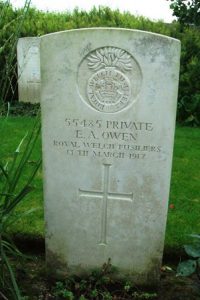
John Pryce Owen, Lance Corporal, 203235, Essex Regiment. John was the son of Pryce and Annie Owen, of Foellwyd, Garthbeibio, Welshpool. He enlisted at Welshpool into the Montgomeryshire Yeomanry prior to the war. On 5 August 1914 the Montgomeryshire Yeomanry was mobilised at Welshpool, as part of the South Wales Mounted Brigade, before moving via Hereford to Thetford, to join the 1st Mounted Division. John did not embark for Egypt with the regiment, but was posted to France and transferred to the 10th Battalion, Welsh Regiment during the summer of 1917. The battalion was attached to 114 Brigade, 38th (Welsh) Division and was holding the Canal Bank sector, north of Ypres. On 31 July 1917 the Division launched its famous assault on the Pilckem Ridge, capturing Iron Cross and reaching its objective of the Steenbeek, then played a supporting role in the Battle of Langemarck. The Division was transferred to the Sailly-sur-la-Lys sector in September, and remained in the area over the winter. At the end of January 1918, the 10th Welsh received the unwelcome news that it was to be disbanded and its officers and men were distributed to other units. John was transferred to the 11th Battalion, Essex Regiment, which was attached to 18 Brigade, 6th Division. The Division was holding a section of the front near Beugnatre, north-east of Bapaume, and on 21 March 1918 was hit hard when the Germans launched the first phase of their Spring offensive, along the section of front running from Croisilles to La Fère. The Division was forced to withdraw, together with the rest of the Allied line, and over the coming days reached Puisieux, before being relieved and entrained at Hondicourt for Elverdinghe on 25 March. After a brief rest, the division took over a sector of front line near Becelaere and Zillebeke Lake from 10 April. The Division remained in the Ypres Salient over the coming months, its battalions carrying out the usual routine of trench rotation. John was killed in action here during a routine spell in the line, on 31 July 1918. The 22-year-old is buried in Nine Elms British Cemetery, Belgium.
John Pardell, Sergeant, 55491, Royal Welsh Fusiliers. John was born at Pendleton, Lancashire on 18 March 1894, the son of Thomas Pardell and Mary Jane Pardell (nee Jones). His father died in 1899 and his mother married Benjamin Gittins in 1904, before moving the family to The Frochas, Castle Caereinion. John worked as a waggoner for David Mackenzie at Frochas prior to gaining a position as a relaying labourer with the Great Western Railway’s Engineering Department at Shrewsbury. He enlisted at Welshpool into the Montgomeryshire Yeomanry in 1915 and was posted to Park Hall Camp, Oswestry for training. In November 1916 he was drafted to France, and joined the 17th Battalion, Royal Welsh Fusiliers. The battalion was attached to 115 Brigade, 38th (Welsh) Division and was holding the Canal Bank sector at Ypres, rebuilding following heavy losses suffered during the attack on Mametz Wood in July 1916. Following its moved to Ypres, the various battalions of the division were kept busy digging and improving the trenches, and also constructing a series of deep dugouts, whilst also carrying out the normal routines of trench rotation. At the beginning of March 1917, the 17th RWF was busy, with its men on various working parties constructing a light railway, wiring and improving trenches. On 31 July 1917 the Division launched its famous assault on the Pilckem Ridge, capturing Iron Cross and reaching its objective of the Steenbeek, then played a supporting role in the Battle of Langemarck. The Division was transferred to the Sailly-sur-la-Lys sector in September, and remained in the area over the winter before being moved to positions north of Albert, at Bouzincourt Ridge, at the end of March 1918, relieving the battered 2nd and 47th Divisions. It held this sector, again carrying out minor operations and trench raids, over the coming months, before taking part in the great offensive of 21 August 1918, and began its advance towards the Hindenburg Line. Over the coming weeks the Division recaptured Thiepval, Pozieres, Mametz Wood, High Wood and Delville Wood, all famous names from the 1916 Somme offensive, before crossing the Canal du Nord, and once the Hindenburg Line had been broken the Division advanced past Le Cateau towards the Forest of Mormal, forcing the crossing of the River Selle. John was wounded during this period, and was evacuated to the 10th General Hospital at Rouen, where he died of his wounds on 2 November 1918. The 24-year-old is buried in St. Sever Cemetery Extension, Rouen, France.
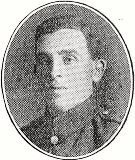
Joseph Albert Pugh, Private, 3024, Royal Welsh Fusiliers. Joseph was born at Castle Caereinion in 1896, the son of Joseph and Amelia Pugh (nee Edwards). His parents later resided at Moat Cottage, Chirbury. Joseph enlisted at Welshpool into the 7th Battalion, Royal Welsh Fusiliers soon after the outbreak of war. The battalion was a Territorial unit, which mobilised for war at Newtown in August 1914, as part of North Wales Brigade, Welsh Division and moved to Conway until the end of the month, before moving to Northampton. In December the Division moved to Cambridge and then in May 1915 to Bedford, where the Division was numbered and the formation became 158 Brigade, 53rd (Welsh) Division. On 19 July 1915 the entire Division sailed from Devonport for Imbros and on 9 August 1915 landed at Suvla Bay. The infantry moved off the beaches into the bush, but due to a lack of maps and no knowledge of the terrain, many of the units became disorientated, and the situation became chaotic. Even as the fighting calmed down, the situation facing the troops at Gallipoli failed to improve. The conditions were dire, with sickness and disease rife among the troops, due to the insanitary conditions, with hundreds of bodies lying unburied in No Man’s Land attracting countless flies. Joseph became ill just weeks after the landing, and was evacuated to the 3rd Australian General Hospital, Mudros, where he died of enteric fever on 6 October 1915, aged 18. He is buried in Portianos Military Cemetery, Lemnos, Greece.
Noel Price James Turner, Lieutenant, Welsh Regiment. Noel was born on 7 December 1878, the son of the Reverend John James Turner and Harriette Augusta Turner (nee Harrison), of Pentreheylin, Llanymynech. He was educated at Charterhouse and at Keble College, Oxford and had served during the Boer War with the Montgomeryshire Yeomanry. Noel married Minnie Beck, an Australian, at Guilsfield, near Welshpool on 25 September 1902 and the couple lived at Sylfaen Hall, Welshpool. Noel was commissioned into the South Wales Borderers on 4 September 1914 and was attached to the 2nd Welsh until joining the 1st Battalion, South Wales Borderers in March 1915. Both the 2nd Welsh and the 1st SWB were attached to 3 Brigade, 1st Division, and had taken part in every major action of the war thus far. By May 1915 the Allies had decided to launch a combined British and French offensive, and the British were tasked with an assault against the Aubers Ridge, the same sector as the unsuccessful Battle of Neuve Chapelle the previous month. The Germans had by now strengthened their defences, and when the battle was launched on 9 May 1915, the 1st Division and the Indian Meerut Division launched their assault on a 2,000-metre frontage from Chocolat Menier Corner, north-east of Festubert, to the Port Arthur cross-roads, south of Neuve Chapelle. Artillery support was inadequate, and the wire had not been cut by the time the troops advanced, and heavy losses were suffered. Noel was badly wounded during the initial charge and was evacuated to hospital in Bethune, where he died later that day, 9 May 1915, aged 36. He is buried in Bethune Town Cemetery, France. Both his sons served as officers with the 7th Battalion, Royal Welch Fusiliers during World War Two.
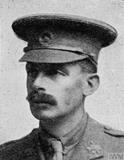
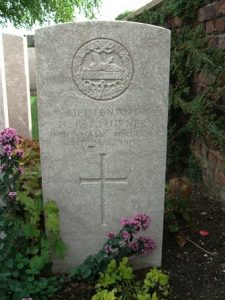
World War Two, 1939-1945
Fred Davies, Civilian. Fred was born on 5 September 1910, the son of George and Mary Davies, of Brookside, Castle Caereinion. He married Violet Mary Proctor, of Castle Caereinion, in 1938, and the couple then lived at 146 Cotterill’s Lane, Alum Rock, Birmingham, where Fred worked as a locomotive fireman. On 9 and 10 April 1941, Birmingham was subject to two heavy air raids by the Luftwaffe. On the first night, some 235 bombers dropped 280 tonnes of explosives and 40,000 incendiaries, concentrated on the city-centre; whilst on the second night some 245 bombers dropped 245 tonnes of explosives and 43,000 incendiaries, causing major damage in Solihull, Hall Green and Erdington. During two nights some 1,121 casualties had been suffered in Birmingham alone. Fred was killed at home on 10 April 1941, during the second nights bombing. The remains of the 30-year-old were brought back home for burial in the Croft Cemetery, Welshpool. There are no WW2 names on the Castle Caereinion war memorial.
Iraq, Op Telic
Paul David Trevor Thomas, Corporal, 25051544, The Light Infantry. Paul was born on 25 January 1975, and resided at Buttington. He enlisted into the 2nd Battalion, The Light Infantry aged 19, and was posted to the Middle East to take part in Op Telic, the invasion of Iraq, in 2003, attached to the 19th Mechanised Brigade. After the fall of Iraq, Paul was attached to the 1st Battalion, the Cheshire Regiment, which was on security duties in Iraq. He was killed when his unit was attacked by a large number of heavily armed gunmen in Basra on 17 August 2004. The body of the 29-year-old was flown back to RAF Brize Norton, and he was buried in Castle Caereinion Cemetery.